Ambroise Odonnat
Provable Benefits of In-Tool Learning for Large Language Models
Aug 28, 2025Abstract:Tool-augmented language models, equipped with retrieval, memory, or external APIs, are reshaping AI, yet their theoretical advantages remain underexplored. In this paper, we address this question by demonstrating the benefits of in-tool learning (external retrieval) over in-weight learning (memorization) for factual recall. We show that the number of facts a model can memorize solely in its weights is fundamentally limited by its parameter count. In contrast, we prove that tool-use enables unbounded factual recall via a simple and efficient circuit construction. These results are validated in controlled experiments, where tool-using models consistently outperform memorizing ones. We further show that for pretrained large language models, teaching tool-use and general rules is more effective than finetuning facts into memory. Our work provides both a theoretical and empirical foundation, establishing why tool-augmented workflows are not just practical, but provably more scalable.
Easing Optimization Paths: a Circuit Perspective
Jan 04, 2025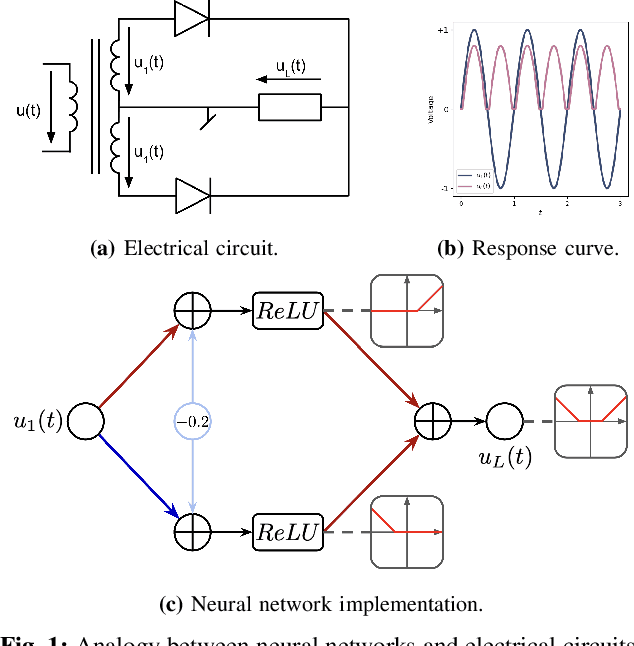
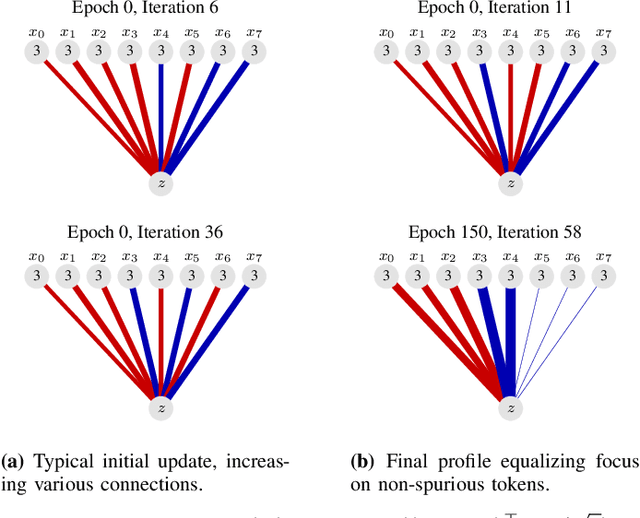

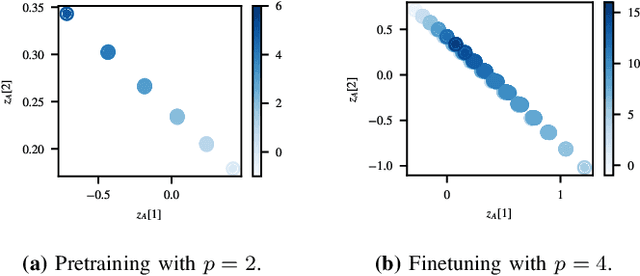
Abstract:Gradient descent is the method of choice for training large artificial intelligence systems. As these systems become larger, a better understanding of the mechanisms behind gradient training would allow us to alleviate compute costs and help steer these systems away from harmful behaviors. To that end, we suggest utilizing the circuit perspective brought forward by mechanistic interpretability. After laying out our intuition, we illustrate how it enables us to design a curriculum for efficient learning in a controlled setting. The code is available at \url{https://github.com/facebookresearch/pal}.
A Visual Case Study of the Training Dynamics in Neural Networks
Oct 31, 2024



Abstract:This paper introduces a visual sandbox designed to explore the training dynamics of a small-scale transformer model, with the embedding dimension constrained to $d=2$. This restriction allows for a comprehensive two-dimensional visualization of each layer's dynamics. Through this approach, we gain insights into training dynamics, circuit transferability, and the causes of loss spikes, including those induced by the high curvature of normalization layers. We propose strategies to mitigate these spikes, demonstrating how good visualization facilitates the design of innovative ideas of practical interest. Additionally, we believe our sandbox could assist theoreticians in assessing essential training dynamics mechanisms and integrating them into future theories. The code is available at https://github.com/facebookresearch/pal.
Zero-shot Model-based Reinforcement Learning using Large Language Models
Oct 15, 2024



Abstract:The emerging zero-shot capabilities of Large Language Models (LLMs) have led to their applications in areas extending well beyond natural language processing tasks. In reinforcement learning, while LLMs have been extensively used in text-based environments, their integration with continuous state spaces remains understudied. In this paper, we investigate how pre-trained LLMs can be leveraged to predict in context the dynamics of continuous Markov decision processes. We identify handling multivariate data and incorporating the control signal as key challenges that limit the potential of LLMs' deployment in this setup and propose Disentangled In-Context Learning (DICL) to address them. We present proof-of-concept applications in two reinforcement learning settings: model-based policy evaluation and data-augmented off-policy reinforcement learning, supported by theoretical analysis of the proposed methods. Our experiments further demonstrate that our approach produces well-calibrated uncertainty estimates. We release the code at https://github.com/abenechehab/dicl.
Large Language Models as Markov Chains
Oct 03, 2024



Abstract:Large language models (LLMs) have proven to be remarkably efficient, both across a wide range of natural language processing tasks and well beyond them. However, a comprehensive theoretical analysis of the origins of their impressive performance remains elusive. In this paper, we approach this challenging task by drawing an equivalence between generic autoregressive language models with vocabulary of size $T$ and context window of size $K$ and Markov chains defined on a finite state space of size $\mathcal{O}(T^K)$. We derive several surprising findings related to the existence of a stationary distribution of Markov chains that capture the inference power of LLMs, their speed of convergence to it, and the influence of the temperature on the latter. We then prove pre-training and in-context generalization bounds and show how the drawn equivalence allows us to enrich their interpretation. Finally, we illustrate our theoretical guarantees with experiments on several recent LLMs to highlight how they capture the behavior observed in practice.
SKADA-Bench: Benchmarking Unsupervised Domain Adaptation Methods with Realistic Validation
Jul 16, 2024Abstract:Unsupervised Domain Adaptation (DA) consists of adapting a model trained on a labeled source domain to perform well on an unlabeled target domain with some data distribution shift. While many methods have been proposed in the literature, fair and realistic evaluation remains an open question, particularly due to methodological difficulties in selecting hyperparameters in the unsupervised setting. With SKADA-Bench, we propose a framework to evaluate DA methods and present a fair evaluation of existing shallow algorithms, including reweighting, mapping, and subspace alignment. Realistic hyperparameter selection is performed with nested cross-validation and various unsupervised model selection scores, on both simulated datasets with controlled shifts and real-world datasets across diverse modalities, such as images, text, biomedical, and tabular data with specific feature extraction. Our benchmark highlights the importance of realistic validation and provides practical guidance for real-life applications, with key insights into the choice and impact of model selection approaches. SKADA-Bench is open-source, reproducible, and can be easily extended with novel DA methods, datasets, and model selection criteria without requiring re-evaluating competitors. SKADA-Bench is available on GitHub at https://github.com/scikit-adaptation/skada-bench.
Analysing Multi-Task Regression via Random Matrix Theory with Application to Time Series Forecasting
Jun 14, 2024
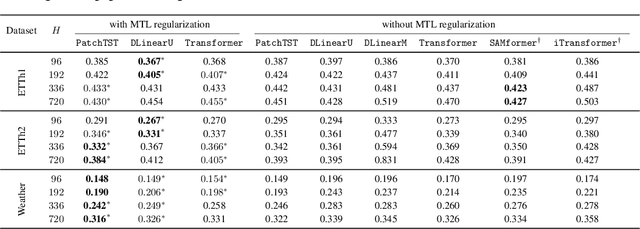
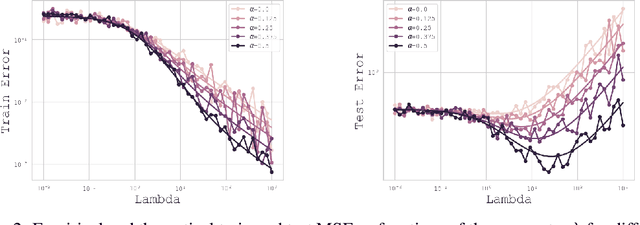
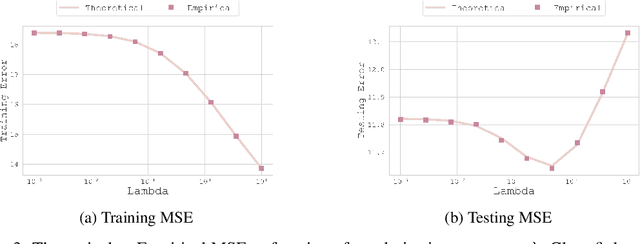
Abstract:In this paper, we introduce a novel theoretical framework for multi-task regression, applying random matrix theory to provide precise performance estimations, under high-dimensional, non-Gaussian data distributions. We formulate a multi-task optimization problem as a regularization technique to enable single-task models to leverage multi-task learning information. We derive a closed-form solution for multi-task optimization in the context of linear models. Our analysis provides valuable insights by linking the multi-task learning performance to various model statistics such as raw data covariances, signal-generating hyperplanes, noise levels, as well as the size and number of datasets. We finally propose a consistent estimation of training and testing errors, thereby offering a robust foundation for hyperparameter optimization in multi-task regression scenarios. Experimental validations on both synthetic and real-world datasets in regression and multivariate time series forecasting demonstrate improvements on univariate models, incorporating our method into the training loss and thus leveraging multivariate information.
MANO: Exploiting Matrix Norm for Unsupervised Accuracy Estimation Under Distribution Shifts
May 29, 2024



Abstract:Leveraging the models' outputs, specifically the logits, is a common approach to estimating the test accuracy of a pre-trained neural network on out-of-distribution (OOD) samples without requiring access to the corresponding ground truth labels. Despite their ease of implementation and computational efficiency, current logit-based methods are vulnerable to overconfidence issues, leading to prediction bias, especially under the natural shift. In this work, we first study the relationship between logits and generalization performance from the view of low-density separation assumption. Our findings motivate our proposed method MaNo which (1) applies a data-dependent normalization on the logits to reduce prediction bias, and (2) takes the $L_p$ norm of the matrix of normalized logits as the estimation score. Our theoretical analysis highlights the connection between the provided score and the model's uncertainty. We conduct an extensive empirical study on common unsupervised accuracy estimation benchmarks and demonstrate that MaNo achieves state-of-the-art performance across various architectures in the presence of synthetic, natural, or subpopulation shifts.
Unlocking the Potential of Transformers in Time Series Forecasting with Sharpness-Aware Minimization and Channel-Wise Attention
Feb 19, 2024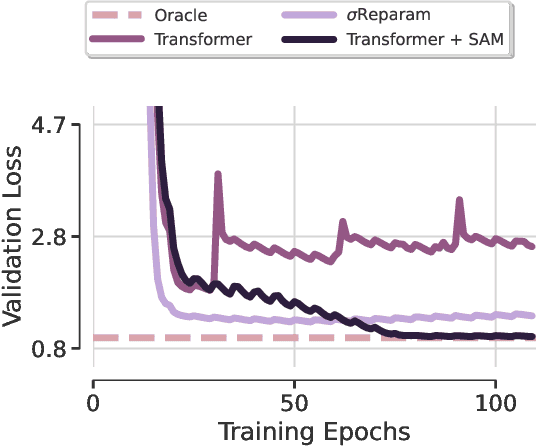
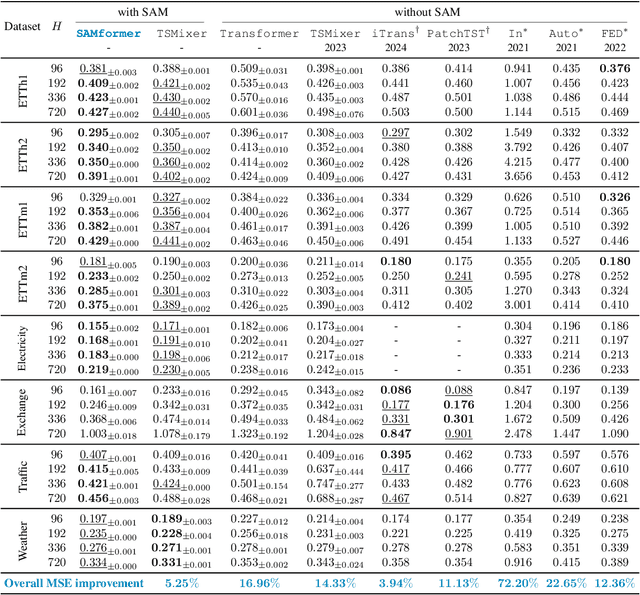
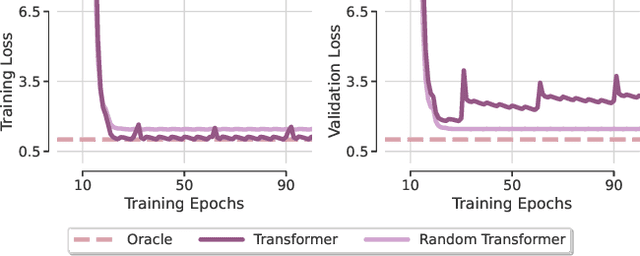
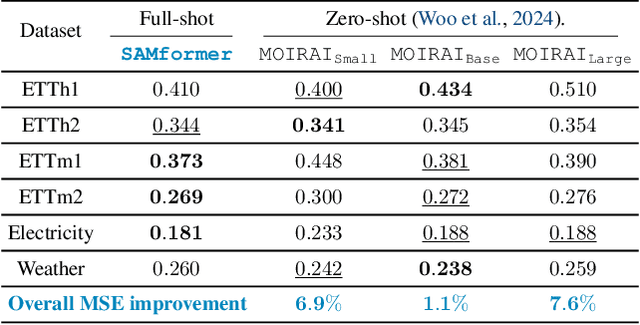
Abstract:Transformer-based architectures achieved breakthrough performance in natural language processing and computer vision, yet they remain inferior to simpler linear baselines in multivariate long-term forecasting. To better understand this phenomenon, we start by studying a toy linear forecasting problem for which we show that transformers are incapable of converging to their true solution despite their high expressive power. We further identify the attention of transformers as being responsible for this low generalization capacity. Building upon this insight, we propose a shallow lightweight transformer model that successfully escapes bad local minima when optimized with sharpness-aware optimization. We empirically demonstrate that this result extends to all commonly used real-world multivariate time series datasets. In particular, SAMformer surpasses the current state-of-the-art model TSMixer by 14.33% on average, while having ~4 times fewer parameters. The code is available at https://github.com/romilbert/samformer.
Characterising Gradients for Unsupervised Accuracy Estimation under Distribution Shift
Jan 17, 2024



Abstract:Estimating test accuracy without access to the ground-truth test labels under varying test environments is a challenging, yet extremely important problem in the safe deployment of machine learning algorithms. Existing works rely on the information from either the outputs or the extracted features of neural networks to formulate an estimation score correlating with the ground-truth test accuracy. In this paper, we investigate--both empirically and theoretically--how the information provided by the gradients can be predictive of the ground-truth test accuracy even under a distribution shift. Specifically, we use the norm of classification-layer gradients, backpropagated from the cross-entropy loss after only one gradient step over test data. Our key idea is that the model should be adjusted with a higher magnitude of gradients when it does not generalize to the test dataset with a distribution shift. We provide theoretical insights highlighting the main ingredients of such an approach ensuring its empirical success. Extensive experiments conducted on diverse distribution shifts and model structures demonstrate that our method significantly outperforms state-of-the-art algorithms.
 Add to Chrome
Add to Chrome Add to Firefox
Add to Firefox Add to Edge
Add to Edge